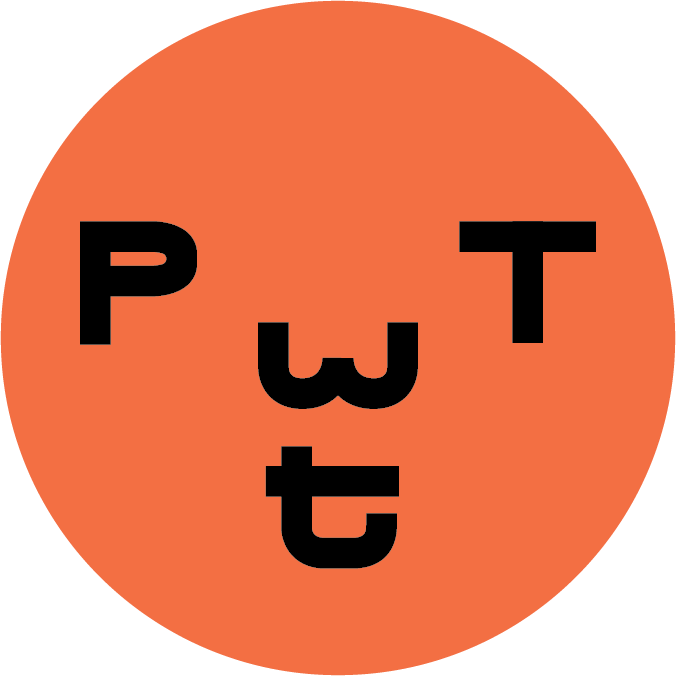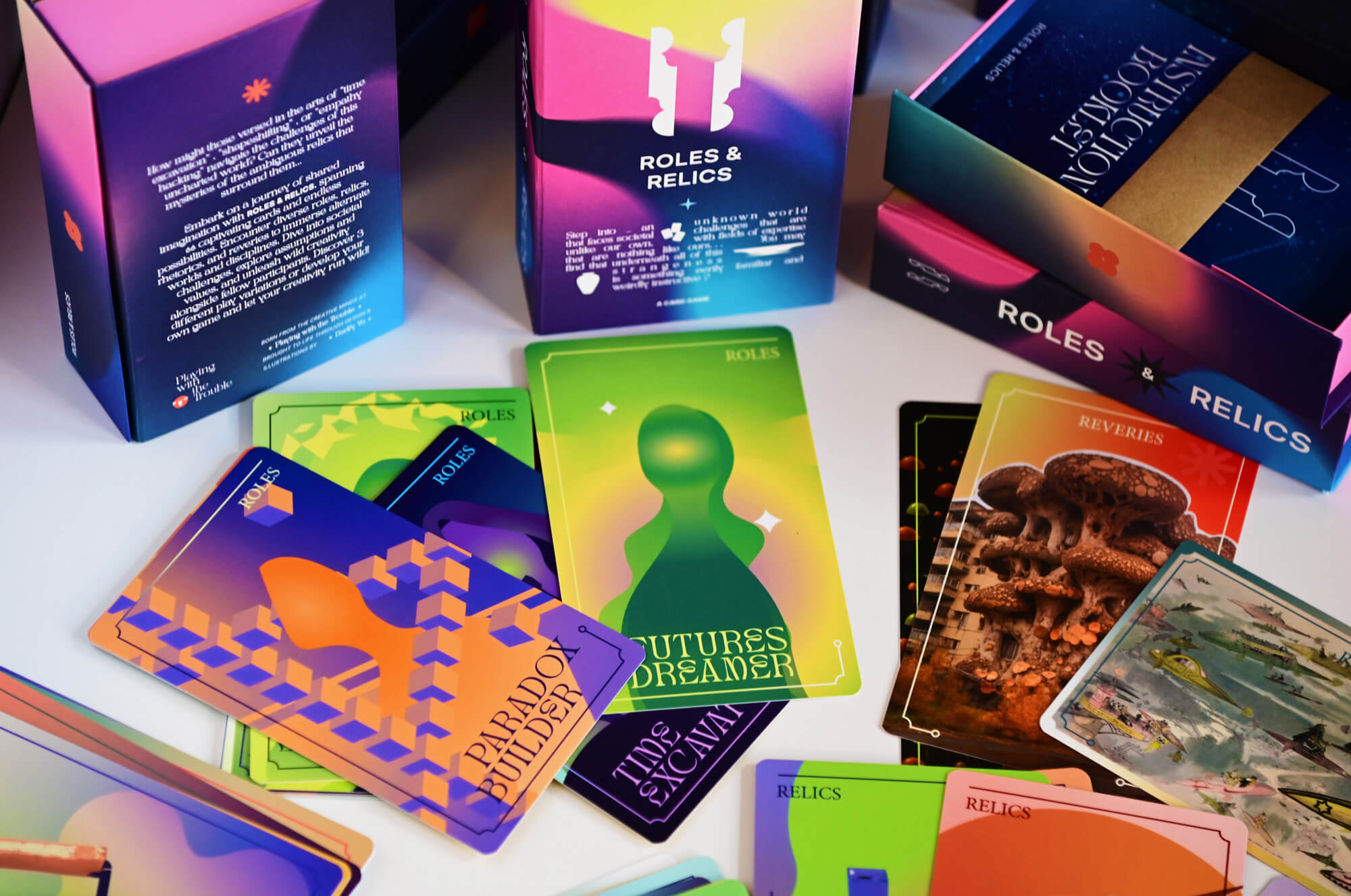
Roles & Relics
Embark on a journey of shared imagination!
A 60 minute activity for 3 or more people
Step into an unknown world that faces societal challenges that are unlike your own. With fields of expertise that are nothing like ours…You may find that underneath all of this strangeness is something eerily familiar and weirdly instructive…
Roles and Relics is a game designed to explore and open-up worldviews, and spark discussion between participants. In small groups you will make use of prompt cards to collectively build new worlds. In the process, you will engage in discussion, reflection, and exploration.
Download a PDF of the Roles and Relics cards
Is this the activity for your group?
- No facilitator required
- ± 60 minutes
- 3 or more people
- Medium setup (requires the ‘Roles & Relics’ card deck (PDF) [need the final version] or a printed version of the cards)
- Low – High difficulty (Follow the instructions of one of the pre-existing games or create your own game with the card deck)
- High imaginative load (requires participants to be creative in making links and imagining worlds)
- Medium trust required
Why play this?
- Collective imagining (Creating and exploring imagined worlds together)
- Surfacing worldviews (Reflecting on each other’s positions and assumptions)
- Embracing ambiguity (Using ambiguity around the meaning of the images and words on the cards as a starting point for generating new ideas and ways of thinking)
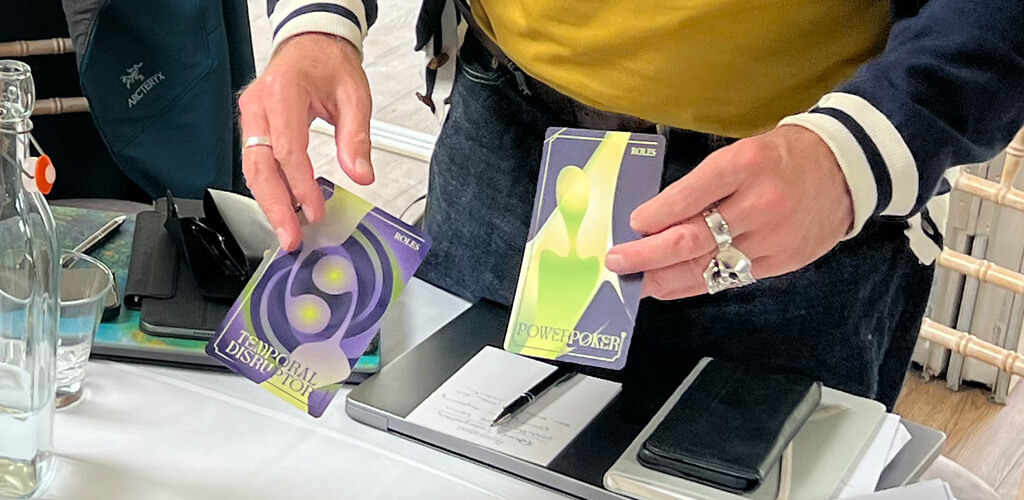
Components
The game includes 4 types of cards:
- Reverie cards represent imagined worlds or situations.
- Rhetoric cards are imagined sentences spoken in the imagined world.
- Relic cards present a mysterious object from the past.
- Role cards reflect a personality-type: a way of being in the world in relation to others.
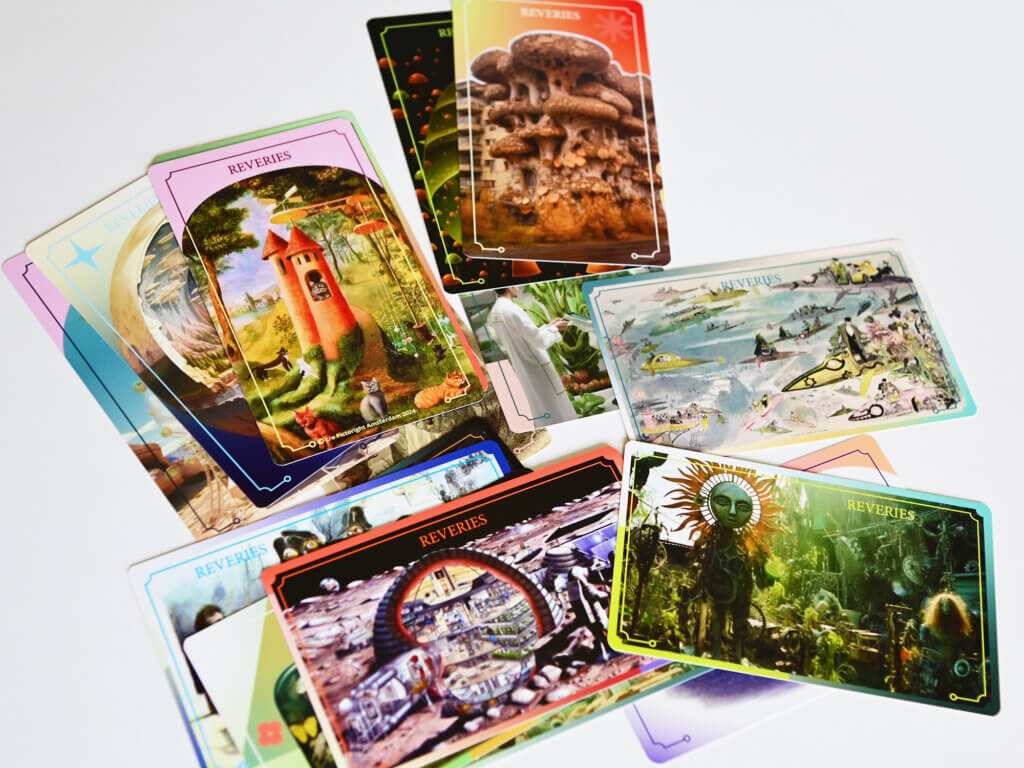
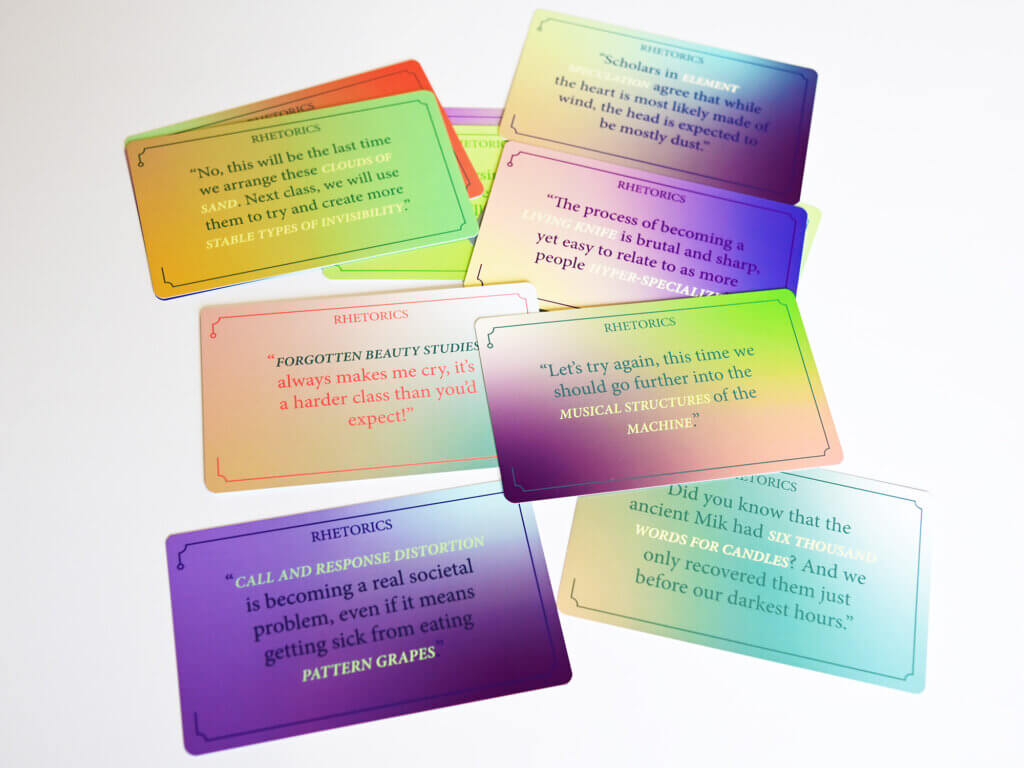
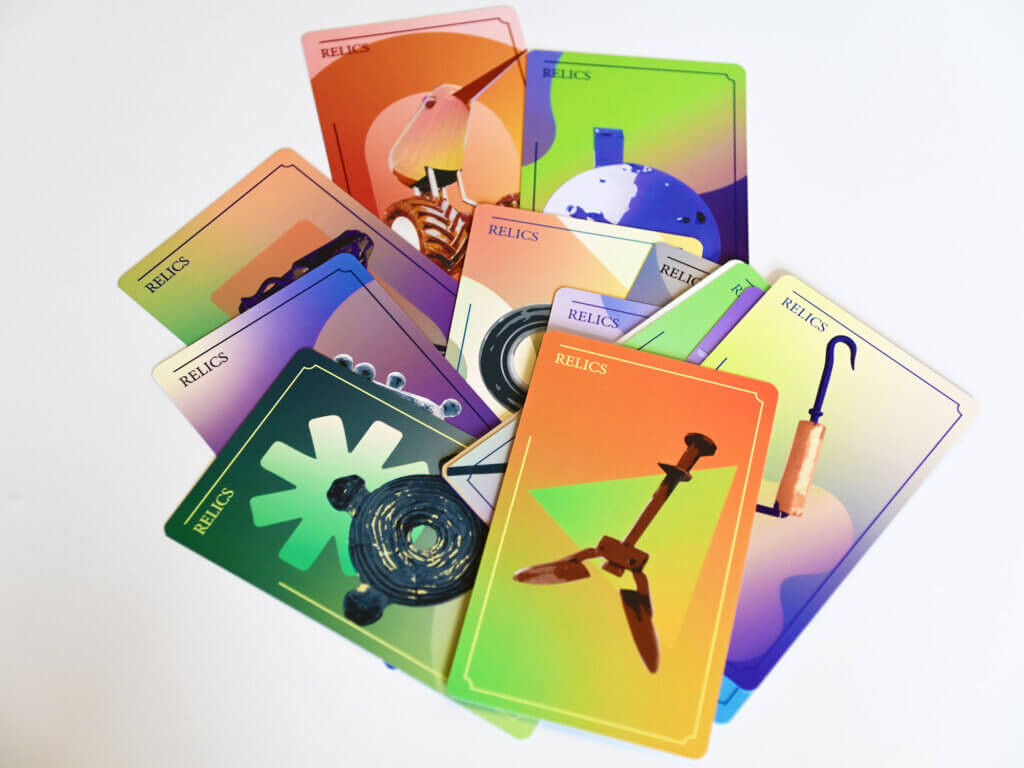
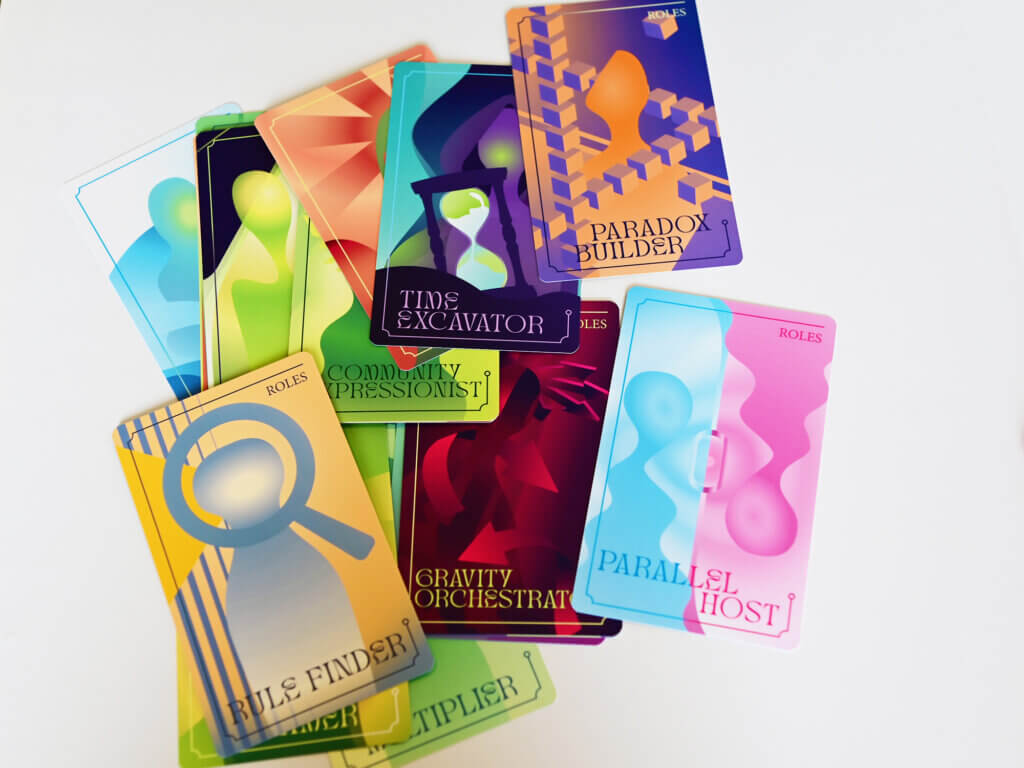
Notes for the organiser/facilitator
There are multiple ways to play the game. To help you get started the instructions included here—and on cards included in the box—describe different variations you can play. You are welcome to deviate from these instructions and adapt them to suit your needs. Since not all playing styles work for everyone or every group, we encourage re-mixing and putting your own spin to it. If you’re not having fun, change the rules!
The rules here are very open, and that is on purpose. The cards have been designed to prompt reflection and discussion. This means some concepts and cards may not make sense to you, and that is OK! You can interpret the cards as you wish, play around with the number of cards you draw, how you cooperate at the table, and many other aspects of the game. If something is not clear, you can swap cards, draw a new card, or, we encourage you to create your own definitions or understanding. It may also be that you do not agree with one another. That is also OK! This is part of the process.

Example game 1: Shared Dreams
In this version of Roles and Relics you use prompt cards to collectively imagine an unusual story set in another world,
offering a new perspective on your own reality.
How to play
Separate and shuffle each of the card types: Roles, Relics, Reveries, and Rhetorics. Read the following steps out loud so
that everyone understands the process.
- Each player places one of the four card decks in front of them. For a game with 3 players: Use only 3 decks
(Reveries, Roles, Relics). - Player 1, with the Reverie deck, places the top card face up in the centre. This player gets 1 minute to describe
the world that this card represents. Don’t be afraid to get creative. This world becomes the setting for the story.
Alternative option: Player 1 is free to select other cards to further develop the story. - Player 2, with the Rhetoric deck, places the top card face up next to the Reverie card. This player gets 1 minute to
build on the story by describing how this statement came about in this imagined world. Who spoke it. Why? With
what intention? To whom? - Player 3, with the Roles deck, places the top card face up next to the other cards. This player gets 1 minute to describe what this person or being is doing now in this world. What are they trying to achieve? How? What motivates them? What troubles them? Why?
- Player 4, with the Relic deck, places the top card face up next to the other cards. This represents a possible pivot
point in the story. This player gets 1 minute to describe how this relic is used in this world. Where was it found?
How was it made? Who is using it now and for what purpose? - The game can end here, but you are encouraged to keep building the story. To do this each player takes a
turn in reverse order (starting with player 3) to advance the story, showing how the role, rhetoric and reverie
respond to the relic and impact one another. Once player 1 has spoken, player 4 can introduce a new relic and the
story building can continue as long as time or motivation allow.
End of game
- In what ways does this story differ from our own world?
- What inspired you about this new world?
- What fears do you have for this world?
- What would you have changed in the story if you had played another card? Why?
- How did you connect different cards and concepts that came up?

Example game 2: Imaginary Worldviews
In this version of Roles and Relics you use prompt cards to collectively imagine a new world, including the most pressing problem it faces. You assume individual roles and make use of relics to address this problem.
How to play
Separate and shuffle each of the card types: Roles, Relics, Reveries, and Rhetorics. Read the following steps out loud so
that everyone understands the process.
- Draw 1 card from the Reveries deck and 1 card from the Rhetorics deck and place the two cards face-up, visible to all. Take a minute to individually think about what kind of world the two cards could belong to. Share these ideas in the group and collectively create a world based on these prompts.
- Once the world is created, collectively decide upon the main problem(s) this world is facing. Keep in mind that
people may have differing interpretations and listen to each other. - Now you will adopt a role in this world. Each player draws 1 card from the Roles deck and 1 card from the Relics
decks. Everyone places their two cards face-up in front of them. - Take a minute to imagine your new Role in this world, and decide the purpose of your Relic. From this role, how can you make use of the relic to start to address the problem facing your world. Introduce yourself in this role to the group, explaining your possible solution to the pressing problems ahead.
- What will happen next? How will you address the problem? What are the opportunities and challenges that come from working together, or working alone? Are there any alliances? Where are the conflicts?
End of game
The game ends when time runs out or when the discussions have ended. After the game, you are invited to reflect on the process. Consider the following questions:
- What moments were exciting or inspiring?
- Where did you get stuck?
- What did the game uncover in terms of different values and perspectives?
- Who’s voices were privileged or excluded during the game?
- What insights does this activity offer for everyday life?

Example game 3: Fictional Research
In this version of Roles and Relics you use prompt cards to collectively imagine a new world, and to occupy it in the roles of specific researchers. Your aim is to work together to construct a transdisciplinary or interdisciplinary research project. This version of the game is interesting for people involved with academic research, and allows players to think up a research project in an unknown, fictional world.
How to play
Separate and shuffle each of the card types: Roles, Relics, Reveries, and Rhetorics. Have one player read all the rules
below out loud before you begin.
First, individually establish the researcher you will be playing, based on a Role card.
- Each player draws 1 card from the Roles deck and places it face-up.
- Interpret your Role as a future scientific discipline. You will play this role—as a scientist of this discipline, for the rest of the game. Choose your key concerns, assumptions, limitations and strengths.
- Do a quick round of introductions.
Then, work together to create the world you will play with.
- Draw one Reverie card and place it face-up. Together, imagine and describe a world from it (~3 minutes): What do you see? How does this fit into the rest of the world? How does the image on the card make you feel? Are parts of the card especially important? Ask each other questions. Once you have some consensus…
- Draw one Relic card and place it face-up. Together, establish the meaning of this Relic to the imagined world. You are welcome to adjust or remove previous notions to make sense of these cards together (~3 minutes).
- Draw a Rhetoric card and place it face-up. Together, complete the world by integrating some meaning from this Rhetoric (~3 minutes). Do any new ideas arise from the combination of these cards?
In the final stage of the game, put the characters to work!
- Plan the basis of a transdisciplinary or interdisciplinary research project (20-30 minutes) from your (scientific discipline) Roles. You may answer questions such as:
- What problem needs to be solved?
- Who needs this solution?
- What do we need to know about the world?
- What is our main research question?
- How can you answer this question?
- What limitations will you encounter?
End of game
The game can end here. Alternatively, you can draw cards from any of the decks to represent your data collection or -analysis. Or you can return to step 1 and discover how your researcher has changed through the collaborative research process.
After the game, you are invited to reflect on the process. Consider the following questions:
- What moments were exciting, surprising, or inspiring?
- Where did you get stuck?
- What moments were similar to trans- or interdisciplinary projects from your own academic practice?
- What experiences from this game would you like to see more in your own academic practice with trans- or interdisciplinary processes.
